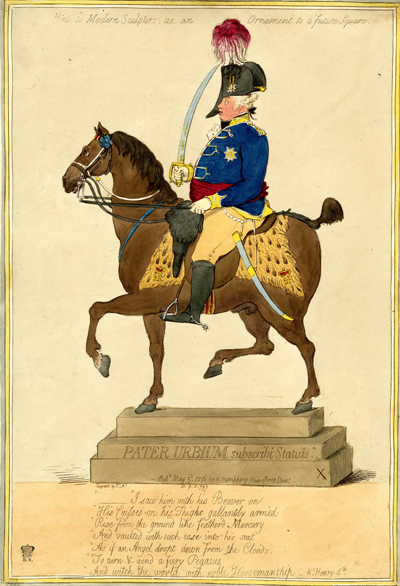Hint to Modern Sculptors, as an Ornament to a Future Square
Gillray's deeply ironic "Hint" to the modern sculptors of his day shows the decidedly obese Prince of Wales in his new Light Horse uniform as a model for a future equestrian statue.

©Trustees of the British Museum
The impetus for the print may have been a chance juxtaposition of stories in The Daily Advertiser for Saturday, April 16, about two weeks before its appearance. Next to a notice of a review in Hyde Park of a 650-man Regiment of Highland Fencible Infantry attended, no doubt in full dress uniform, by the King, the Prince of Wales, the Duke of York, and other notables was this:
The Emperor has determined upon the Erection of an Equestrian Statue of his late Uncle, Joseph II, in one of the Squares of Vienna. M. Zauner is the Artist, and his Model has been much approved.
With the plans of a statue by M. Zauner already part of the current news, Gillray may felt that this was a golden opportunity to supply his own ironic design with the incongrously unfit "Prince of Whales" as he was sometimes called as grotesque model.
Though Gillray was never averse to poking fun at the Prince's size, there are two allusive quotations included in the print that provide a larger satirical context. The first and most recognizable is from Shakespeare's Henry IV Pt 1 Act IV Scene 1 when the rebellious Hotspur is preparing to meet the King's forces at Shrewsbury. It is then he learns from several messengers that the promised support for his own forces is dwindling and that he will now have to face a newly energized and committed Prince of Wales who will ultimately kill him in hand to hand combat.
I saw young Harry, with his beaver on,
His cuisses on his thighs, gallantly arm'd
Rise from the ground like feather'd Mercury,
And vaulted with such ease into his seat,
As if an angel dropp'd down from the clouds,
To turn and wind a fiery Pegasus
And witch the world with noble horsemanship.
Needless to say, the present Prince of Wales seems hardly capable of climbing yet alone vaulting to his saddle and his somewhat heavy-set mount is not about to rival Pegasus. And though the two Princes share misspent youths, there was no sign that the current Prince would ever rival young Harry or become a King like Henry V, a conqueror of France.
The second, and perhaps more pointed, allusion is provided by the inscription on the pedestal. It is from Book Three Ode 24 of Horace and was part of the epigraph of Swift's A Project for the Advancement of Religion and the Reformation of Manners. In general, Ode 24 argues that riches are no shield against fear and death, and that a simple life may be preferable. And that strict laws are more and more necessary to curb the present lust for luxury and licentiousness.
The specific lines from which Gillray derives his inscription are these:
O quis quis volet impias
Caedes et rabiem tollere civicam?
Si quaeret Pater Urbium
Subscribi statuis, indomitam audeat
Refrenare licentiam,
Clarus postgenitis...
The translation of Christopher Smart (1722-1771) of these lines is:
O if there be any one willing to remove our impious slaughters, and civil rage; if he be desirous to be written father of the state, on statues [erected to him], let him dare to curb insuperable licentiousness, and be eminent to posterity;
Horace's reference was to Augustus who was credited with trying to improve the morals of the country during his reign. But the drinking, gambling, whoring, adulterer known as the Prince of Wales was not likely to follow his example.
Sources and Reading
- Commentary from the British Museum on Hint to Modern Sculptors, as an Ornament to a Future Square.
- "George IV of the United Kingdom," Wikipedia
- Complete text of Henry IV Part 1.
- Christopher Smart's translation of the Third Book of Horace's Odes.
Comments & Corrections
NOTE: Comments and/or corrections are always appreciated. To make that easier, I have included a form below that you can use. I promise never to share any of the info provided without your express permission.